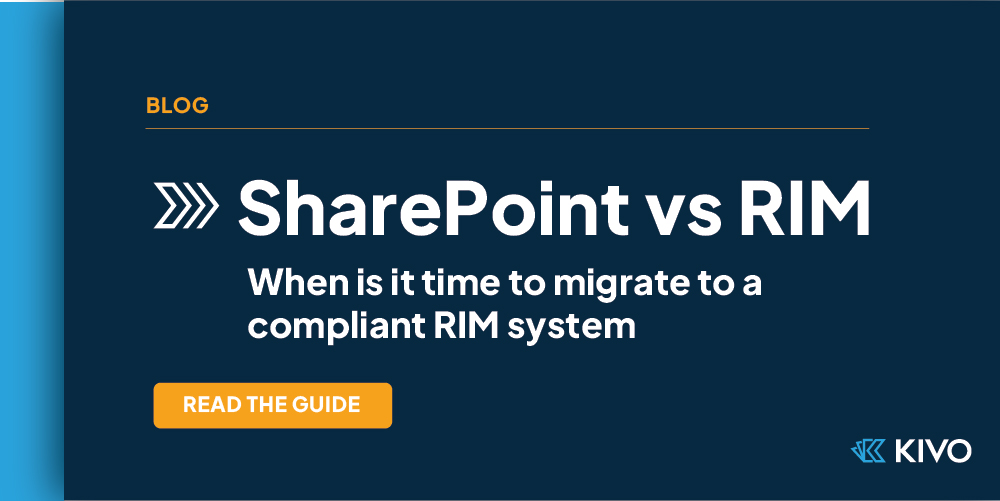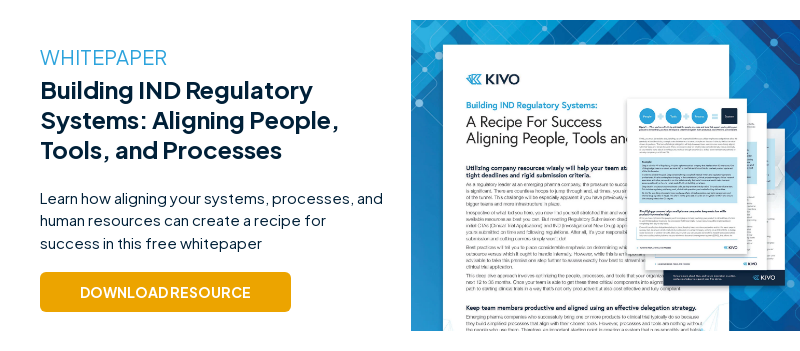Are you a regulatory leader trying to meet tight submission deadlines with distributed teams and multiple vendors responsible for various content? You are not alone. Many sponsors are wrestling with the same challenges.
Often, we encounter emerging pharma teams at cross-roads in their growth. In the early stages (pre-IND and Phase 1), SharePoint is one of the most popular solutions for storing, collaborating, and maintaining regulatory documents. Although SharePoint is simple to start using and is low cost, it does not consider the unique needs of regulatory or the regulated industry in general. And as clinical trials progress into Phase 2, SharePoint can start to break down. From version control issues to lost edits and more, using SharePoint as your central regulatory information repository can hinder your ability to meet submission deadlines.
An alternative to SharePoint is a purpose- built Regulatory Information Management (RIM) System. In this article, we'll discuss what a RIM System is, why SharePoint is not the best fit for the regulatory industry, and finally, what to look for in a RIM Solution.
What is a RIM System?
Regulatory Information Management (RIM) covers many tasks, management functions and cross- functional touch points. Regulatory professionals oversee the process of getting a drug or product through governmental agency review and approval, such as FDA or EMA. They also must ensure that an organization's product abides by the regulatory standards outlined by the FDA or ICH.
RIM Systems typically include the following features and use cases:
- Submission Forecasting and Resource Planning
- Dossier Management (content plan, distribution, archive)
- Submission and Electronic Document Management (EDMS)
- Submission
- Submission Planning and Tracking
- Product Registration Management
- Health Authority Commitment Management
- Health Authority Interactions (Q&A, Correspondence)
- Regulatory Archive
- Label Management
- Reporting, Analytics, Dashboard
- Data Standards and Governance Management
- Design History File (Medical Device)
- Regulatory Intelligence
The number of documents required by these regulatory bodies can be staggering. In addition to the high volume of materials needed, there are extensive regulations outlining how documents need to be formatted, how changes to these documents must be recorded (the audit trail), and how they must be approved by various stakeholders.
A Regulatory Information Management (RIM) System is software designed to help manage the process for these clinical trial submissions. We could spend many blogs simply discussing the scope of RIM and defining the components. That said, every RIM System requires two critical functions: Submissions and Document Management.
SharePoint, despite being compliant with some of these guidelines, is not purposely designed for a highly regulated industry.
Challenges with SharePoint for Regulatory Information Management (RIM)
SharePoint is industry agnostic. It can be used for document storage, project management, for purchase requests, or even as an internal newsletter! But this flexibility means that it doesn't cater to any specific industry, organization or provide templated workflows. In a highly regulated industry such as pharmaceuticals, this can create many challenges and compliance issues.
Here are 10 possible challenges you may encounter using SharePoint for Regulatory Information Management:
- Difficult if not impossible to validate per FDA’s 21 CFR Pt 11 Guidance for Electronic Records and Electronic Signatures.
- No out-of-the-box audit trail to accurately capture user actions in the system.
- Collaboration sessions often fail, experiencing loss of data or edits while authoring and reviewing documents either for submissions or other regulatory activities.
- Folder structure does not follow any data standards like EDM, IDMP, ICH or eCTD; therefore, the environment is often an uncontrolled listing of folders and files without a compliant structure.
- Difficulty in creating reports on status of documents or submissions, forcing regulatory to create manual spreadsheets.
- Metadata or “tagging” is uncontrolled and does not follow any standards like EDM, ICH, eCTD or TMF.
- Conversion to PDF is difficult and it does not convert to ICH or FDA specifications for submissions.
- Requires 3rd party e-signature solution. e.g., DocuSign.
- Workflows that do not match regulatory document control and creation practices.
- Questionable data security and user permissions, compared to pharmaceutical software standards. For example, are you sure your system meets GDPR requirements today?
These challenges run the gamut from being annoying, to the loss of many hours, to a status of noncompliant for electronic records for RIM functions.
|
A true story about a Sponsor using SharePoint: A Sponsor was recounting the difficulties they had encountered with their initial IND application. They were using SharePoint for document collaboration, workflows, edits, and approval processes. Often during critical tight turnaround moments, SharePoint would crash and lose the most recent edits. The regulatory team would then need to re-create the document from scratch. Since the regulatory team could not depend on SharePoint for collaboration and sharing content, they resorted to emailing documents for review. By utilizing email, the audit trail and document history tracking is lost. By moving to a purpose-built RIM with powerful EDMS and collaboration, the client confidently prepares, reviews, and approves content for regulatory submissions. All edits and comments are captured in the RIM system. Multiple people participate without fear of loss of content or data. Since all work is processed within the RIM solution a complete audit trail exists. The client maintains compliance AND functions efficiently. |
How does a RIM System address these challenges?
Unlike SharePoint, RIM Systems are designed expressly for pharmaceutical organizations. The building blocks of an effective RIM system are a compliant EDMS, submission and collaboration solution. In a nutshell, a RIM solution can prove via validation documentation that there is control, organization and access to electronic records and documents. Overall, using a purpose-built system can ease your processes and improve your time to submission.
But how do you choose the right RIM system for you?
First, consider your goals and requirements based on your submission workload and number of team members. Avoid buying a too complicated system with bells and whistles that may or may not be utilized in the next 6-36 months - it will make it more complicated for your team to get up and run quickly. Instead, establish the must-haves to meet regulatory compliance requirement as well as business process productivity tools that align to your workflows.
Compliance Requirements for the Submission and Electronic Document Management (EDMS) Function must include:
- Provide access control to documents based on users.
- Provide an electronic record of person, date and action of every action in the system-i.e., Audit trail.
- Provide centralized storage for data.
- Provide high-level information security.
Second, we would recommend you look for the following business productivity capabilities in your RIM solution:
- Facilitate information creation, retention, and distribution.
- Ensure fast and easy information retrieval via a familiar folder structure based on industry standards like EDM, ICH CTD or TMF.
- Support search.
- Support content-driven collaboration. Utilizing an integrated powerful collaboration tool set that enables multi-users, online and offline functionality and simple tools to create new versions.
- Offer automated workflows with straightforward options created specifically for RIM.
- Pre-built authoring templates following ICH guidance.
- Time saving automation for repeatable folder structures.
- User interface that is pleasing and simple to understand. Will your users “get” it?
- PDF conversion following ICH and FDA guidance.
So what is the best RIM System for your organization?
Ultimately, each organization must analyze their own processes and stage of maturity to determine what scope of RIM System meets your needs. In addition, a RIM System alone is not a silver bullet. You must align your tools with the right people and processes to maximize your existing resources, manage vendor relationships, and stay on track to submission. For more on this topic, check out our whitepaper on building IND regulatory systems below.
That said, a RIM System is an essential component of a successful regulatory team. So what should you look for? Here are 10 use cases we recommend all sponsors consider as they evaluate a system.
10 Regulatory Use Cases to look for in your RIM System:
- Easy bulk import for CRFs, Literature References, and Datasets inclusive of applying metadata matching ICH eCTD, TMF, EDM, RIM or internal company standards.
- Capturing collaboration edits in real time and ensuring a compliant audit trail.
- Ease of organizing and applying a status to all submission documents.
- Create content, track and meet Health Authority Commitments. e.g. DSUR, Annual Reports.
- Manage Health Authority Correspondence: can you answer questions such as, "Where is the correspondence stored? How do I keep track by drug or biologic or contact? Which sequence is it in reference? When is a response due? What supporting content is required?
- Reporting / ease of answering the following example questions:
- Status of submission- What state is the content in?
- What state is publishing in?
- Where do I have active IND/CTAs?
- Where do I have approval to run clinical trials?
- Where am I approved for marketing authorization?
- What is my planned submission schedule for the next 3-12 months?
- How many man hours will it take to complete the tasks associated with the planned submission schedule for 3-12 months?
- Viewing and knowing what version of the documents each agency has under review.
- Search capabilities - is it easy to find what you need?
- Importing , viewing and archiving eCTD sequences.
- Building eCTD content and knowing which documents are required.
In our next Regulatory article, we will discuss how you can leverage a RIM System to power your electronic document management workflows. In the meantime, feel free to explore Kivo's RIM platform and see if it is a good fit for your team.




